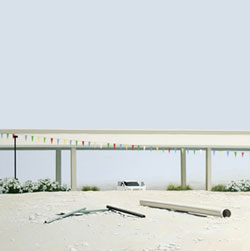
"Dealer," 2008, Acrylic on canvas

January 27, 2009
Jake Longstreth: All It Is
By Victoria Gannon
I drove by a Jake Longstreth painting last month. Just outside of Reno, although it could've been Ohio or Indiana. Cresting hills on I-80, I pointed to a beige building that once housed a Super K-Mart. Now deserted, it was surrounded by a sprawling city oversaturated with chain stores, ringed by housing developments whose residents can't pay their bills. (Nevada had the nation's highest foreclosure rate in 2008.) Longstreth, an Oakland artist, paints suburban sameness in the form of big box stores, oleander bushes, tennis courts, and swimming pools -- the ubiquitous details of the landscape meant to indicate material abundance and leisure. He's been driving across the country capturing these bleak scenes for several years, but his perspective seems particularly relevant right now.
While Longstreth's images of vacant construction sites and tennis courts once read as dispatches from an ever expanding suburban sprawl, they now appear as glimpses of a ruinous future; a preview of what it will look like when all the people have moved out. A small selection of the artist's recent work is on display at the Gregory Lind Gallery through January 31, 2009. All it is asks viewers not to get their hopes up; it presents nine scenes that are understated, stark, and just outside your car window.
Longstreth strips landscapes to their essentials, framing the dreary day-to-day views that come before our eyes but rarely register on our brains. In Sonoma, a blanched store wall serves as support for a red sign spelling "pharmacy" in capital letters. The Sonoma region is better known, of course, for its vistas of vineyards and rolling hills than its Targets or Wal-Marts. But Longstreth shows us how these uniform scenes, on view across the country, are equally accurate portraits of place. Small Town In-Ground showcases a suburban status symbol -- the backyard swimming pool. Empty of people, framed by shadows and trees, the icy body of water perfectly communicates the lonesomeness that can pervade the suburbs. What did we sacrifice to get here?
Longstreth's paintings appear at a turning point in suburban meaning, as one-time symbols of middle-class comfort now emblemize failed dreams and mass displacement. I want to know what the next post-apocalyptic landscape will look like. I picture a foreclosure-ridden, post-suburban frightscape, in which empty big box stores become home to roving bands of gypsies and skateboarders finally have free reign over the parking lots.
All it is is at the Gregory Lind Gallery, 49 Geary St., San Francisco, through January 31, 2009.